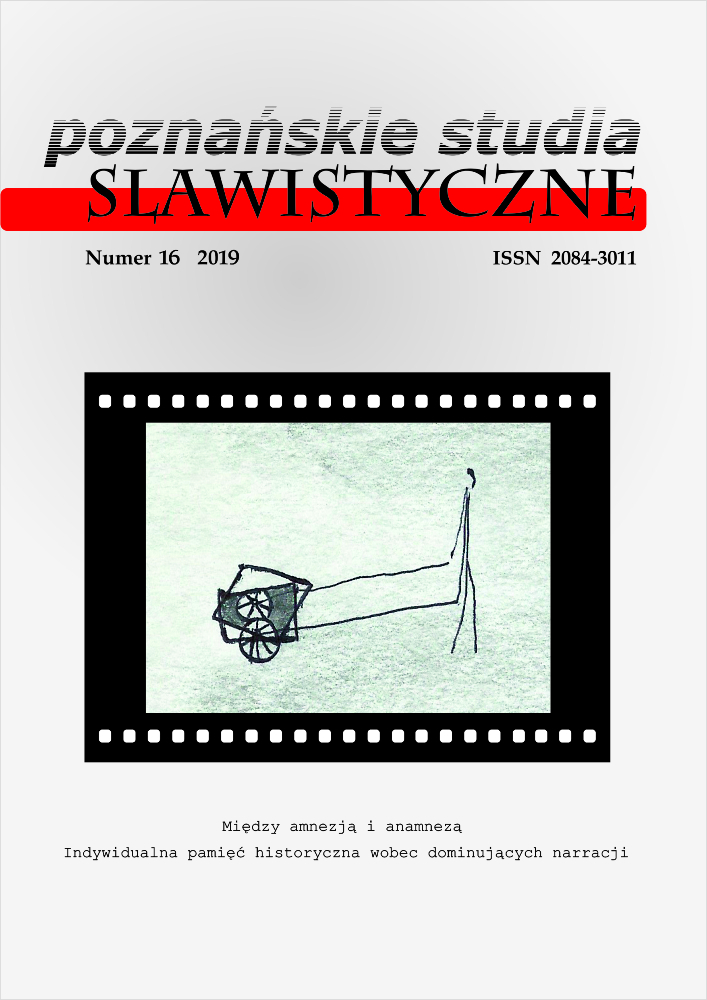Abstract
The text concerns the camp for political prisoners established in 1949 in Yugoslavia on Goli Otok island. This theme was almost entirely absent from public discourse before the 1980s, and real changes and developments in discussions about this part of the history of postwar Yugoslavia occurred only after Tito’s death. Goli Otok as the largest and most infamous camp in communist Yugoslavia is considered a symbol, its name recognized as a synonym of a physical and psychological system for destroying people. In the text I analyze autobiographical texts written by women prisoners (such as Milka Žicina and Vera Cenić). A large number of female inmates were sentenced just for being related to or keeping close contact with a male “enemy of the state”. Thus women were treated not as independent subjects, but as mothers, sisters and wives subordinate to male family members. The social exclusion of women prisoners and their families exacerbated the feeling of isolation and continued after leaving the camp. I am interested in the detail of the strategies of storytelling which are related to spirituality (focusing on nature) both during the period of isolation, when they searched for a way to survive it, as well as after release when the women tried to start a new life.References
Baratay, É. (2018). Zwierzęcy punkt widzenia. Inna wersja historii. Trans. P. Tarasewicz. Gdańsk.
Barcz, A. (2015). I zwierzęta mają historię… O książce Érica Barataya. “Zoophilologica. Polish Journal of Animal Studies” no. 1, pp. 309–316.
Barcz, A. (2016). Realizm ekologiczny. Od ekokrytyki do zookrytyki w literaturze polskiej. Katowice.
Gruenwald, O. (1987). Yugoslav Camp Literature: Rediscovering the Ghost of a Nation’s Past-Present-Future. “Slavic Review” vol. 46, no. 3/4, pp. 513–528.
https://doi.org/10.2307/2498101
Jambrešić-Kirin, R. (2009). Komunističko totalitarno nasilje: žene na Golom otoku i sv. Grguru. http://sjecanjazena.eu/renata-jambresic-kirin-komunisticko-totalitarno-nasilje-zene-na-golom-Otoku-i-sv-grguru/. 30.06.2013.
Kosić, I. (2009). Goli otok. Najveći Titov konclogor. Zagreb.
Kowalska, M. (2011). Dostojewski i Sołżenicyn. Droga do Boga. In: Fiodor Dostojewski i problemy kultury. Ed. A. Raźny. Kraków, pp. 238–248.
Krupiński, P.(2016). ”Dlaczego gęsi krzyczały?”. Zwierzęta i Zagłada w literaturze polskiej XX i XXI wieku. Warszawa.
Latour, B. (2009). Polityka natury. Nauki wkraczają do demokracji. Trans. A. Czarnacka. Warszawa.
Lebl, Ž. (1990). Ljubičica bela: Vic dug dve i po godine. Gornji Milanovac.
Marković, D. (1987). Istina o Golom otoku. Beograd.
Nikliborc, A. (2010). UwięziONE w KL Auschwitz-Birkenau. Traumatyczne doświadczenia kobiet odzwierciedlone w dokumentach osobistych. Kraków.
Petranović, B. (1988). Istorija Jugoslavije 1918–1988, vol. 3: Socijalistička Jugoslavija 1945–1988. Beograd.
Taczyńska, K. (2014). Odzyskać przeszłość – obóz Goli otok w relacjach kobiet. Przypadek Milki Žiciny, In: Miscellanea Posttotalitariana Wratislaviensia: Postkolonializm – tożsamość – gender. Europa Środkowa, Wschodnia i Południowo-Wschodnia. Ed. A. Matusiak, pp. 267–279.
Taczyńska, K. (2015). U potrazi za strategiјama preživljavanja – logorska proza Milke Žicine. “Knjiženstvo” no. 5. http://www.knjizenstvo.rs/magazine.php?text=158. 30.12.2018.
Taczyńska, K. (2016). Dowcip trwający dwa i pół roku. Obraz Nagiej Wyspy w serbskim dyskursie literackim i historycznym końca XX i początku XXI wieku. Warszawa.
Taczyńska, K. (2018). A Border Biography: the Image of the Past in Eva Nahir Panić’s Memories on the Example of Dane Ilić’s Eva. “Studia Judaica” no. 1 (41), pp. 77–95.
https://doi.org/10.4467/24500100STJ.18.005.9175
Ubertowska, A. (2015). Kobiety i historia. Od niewidzialności do sprawczości (wprowadzenie). In: Kobiety i historia. Od niewidzialności do sprawczości. Eds. K. Bałżewska, D. Korczyńska-Partyka, A. Wódkowska, Gdańsk, s. 7–24.
Žicina, M. (2002). Sve, sve, sve…. Zagreb.
Vukmanović, LJ. (2009). Samoće Milke Žicine. In: M. Žicina. Sama. Beograd, pp. 5–16.
Garonja Radovanac, C. (2003). Praštanje čoveku, vlasti i ideologiјi (povodom romana Milke Žicine „Sve, sve, sve” o stradanju u ženskom logoru u Stocu). “Naš trag” no. 1/03, pp. 135–152.
Garonja Radovanac, S. (2012). Rezoluciјa Informbiroa (IB) 1948. u srpskoј književnosti koјu pišu žene (Iz rukopisne zaostavštine Milke Žicine). “Književna istoriјa” no. 147, pp. 367–397.
Denić, C. (2005). Književnost i logori. Larus argentatus – večni let Vere Cenić. In: C. Denić, Opšte i lično. Ogledi o književnosti. Beograd, pp. 61–72.
Žicina, M. (2009). Sama. Beograd.
Mihailović, D. (1990). Goli otok, knj. 1. Beograd.
Cenić, B. (1994). Kanjec filjma. Povest. Vranje.
License

This work is licensed under a Creative Commons Attribution-NoDerivatives 4.0 International License.

